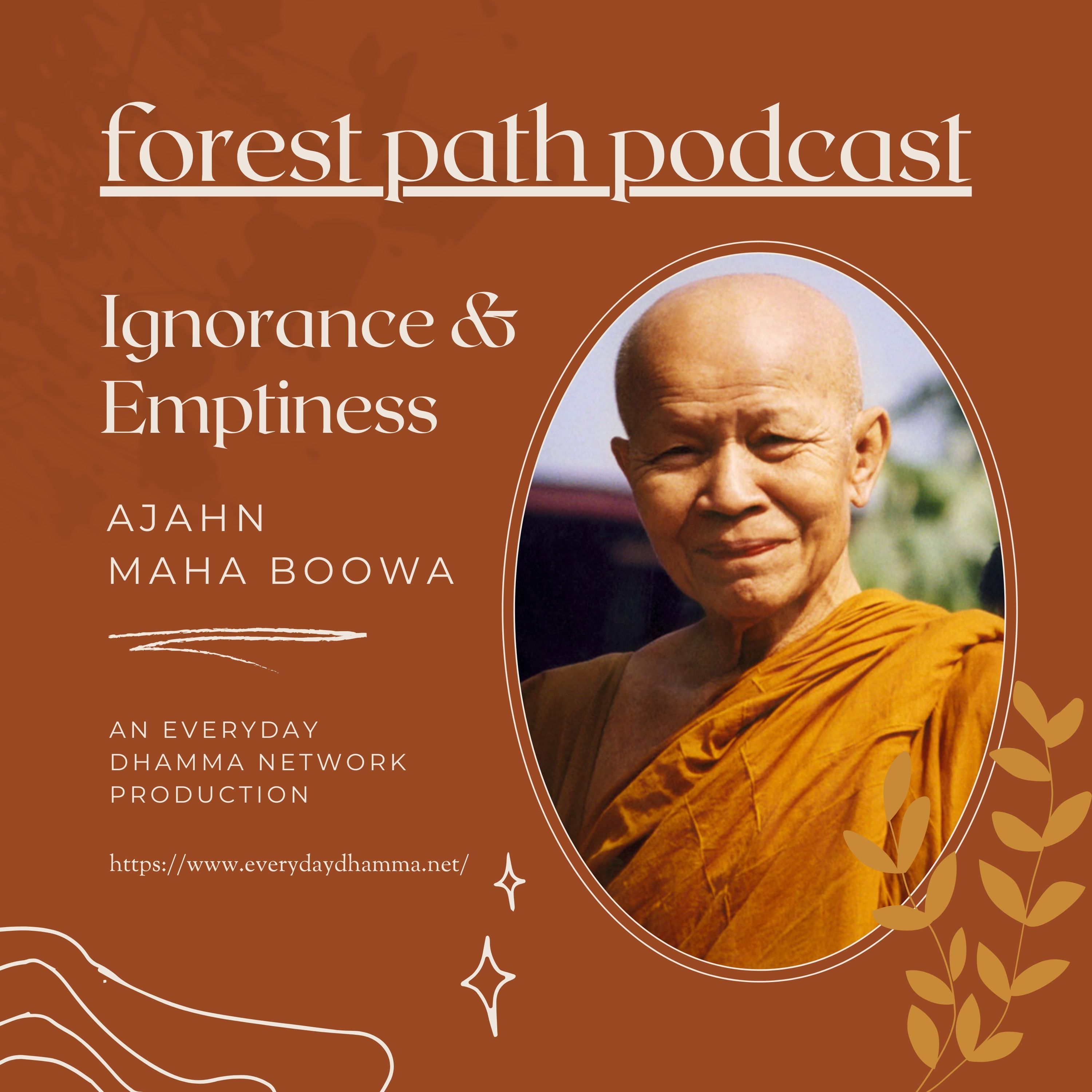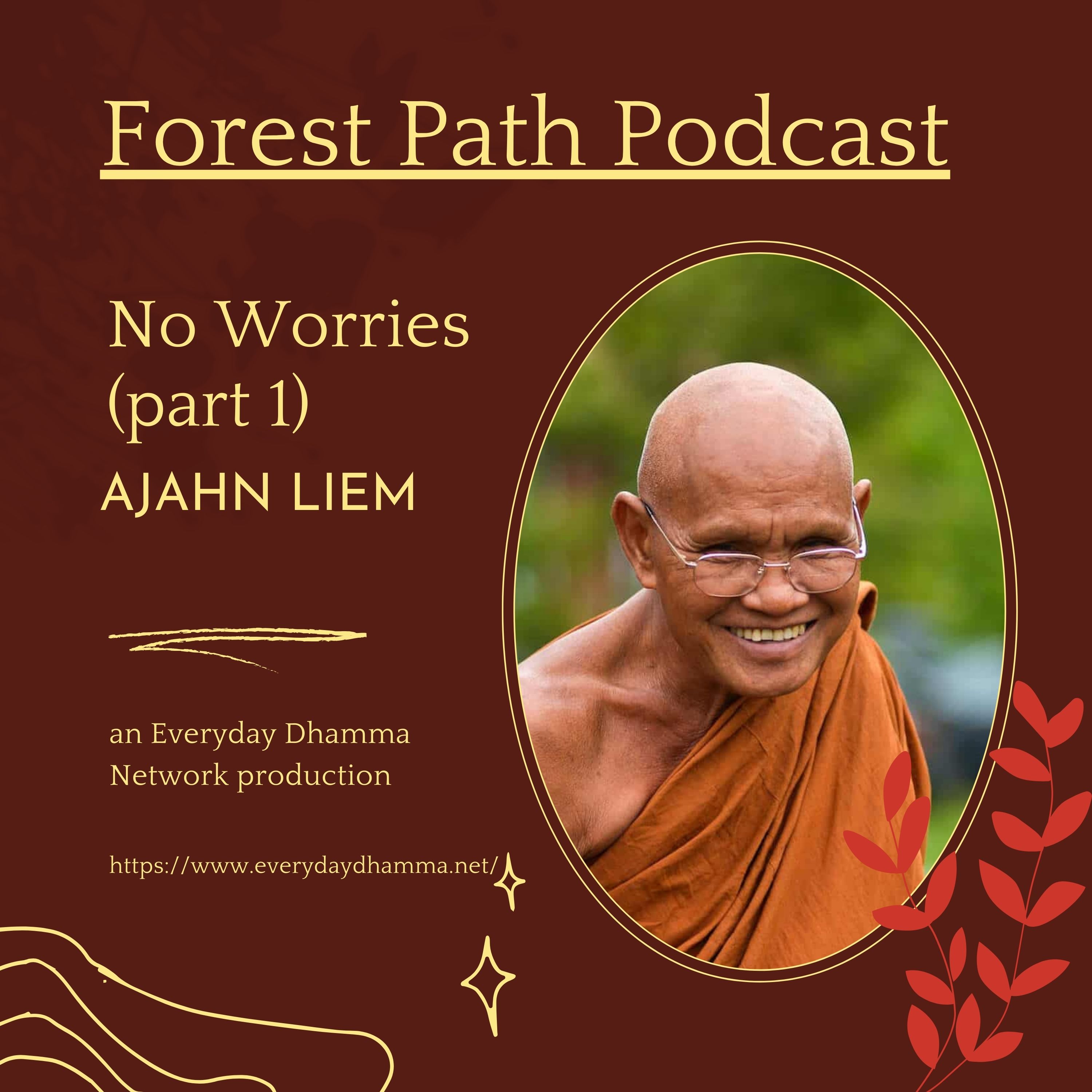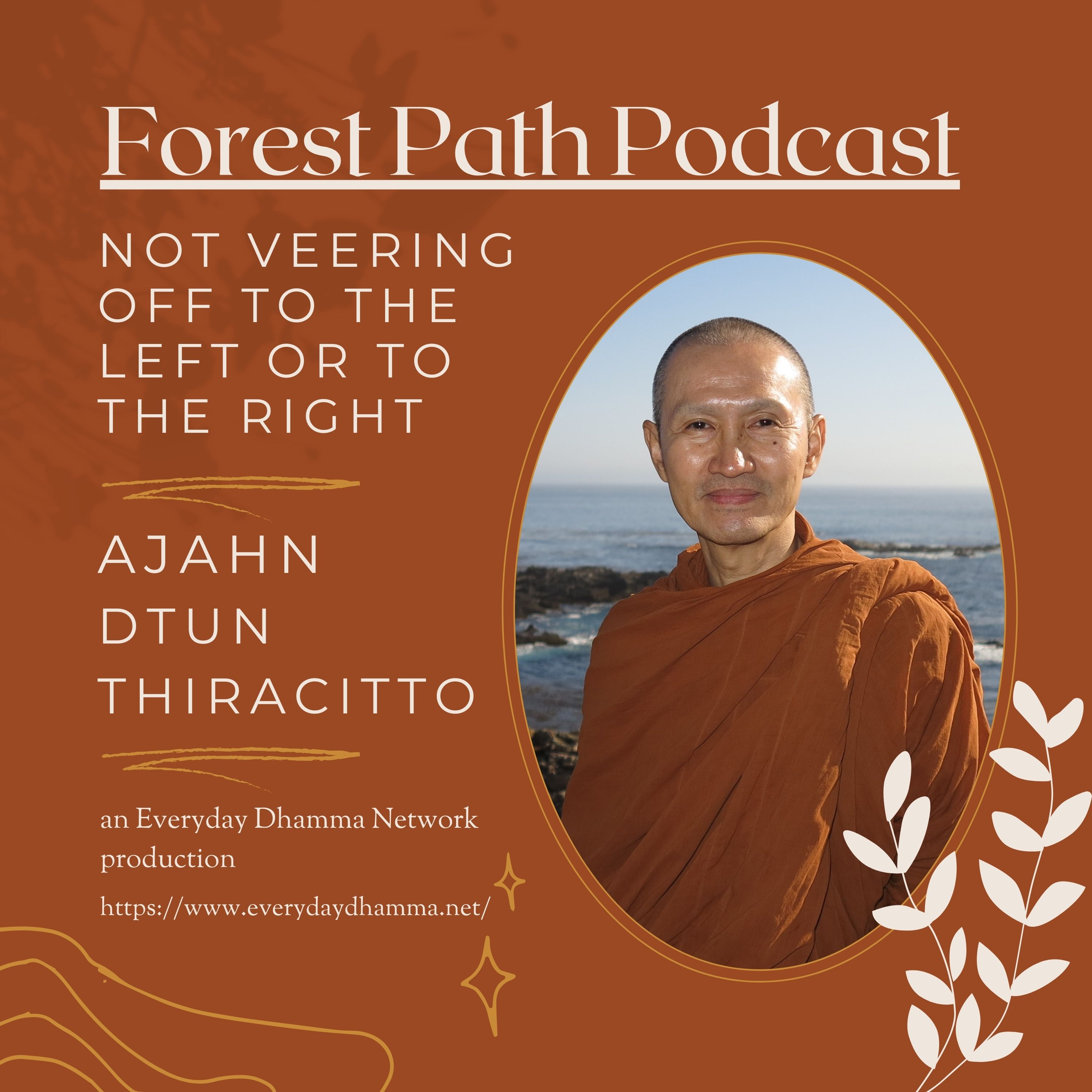Episode Transcript
Ignorance and Emptiness
by Ajahn Maha Boowa
I’d like to take the opportunity to tell you about my own ignorance and doubts, with the realization that we all come from the land of ignorance and doubt in as much as our parents and their ancestors were born with defilements that led them to ignorance as well. There’s probably not one of us here who slipped through to be born in the land of intelligence and freedom from doubt. This being the case, we must all be subject to doubts. Each of us, before starting the practice and in the beginning stages of the practice, is sure to suffer from ig- norance and doubt, as these are the factors that lead to the states of becoming and birth into which all living beings are born. When we lay the groundwork for practice, we don’t have enough starting capital for intelligence to take the lead in every situation, so ignorance is sure to find an opening to take the lead. If we have never trained our intelligence to show us the way, the ignorance that holds the upper hand in the heart is sure to drag us in the wrong direction as a matter of course.
In the beginning of my own training, I felt doubts about whether the teachings of the Buddha – both the practices to be followed and the results to be obtained – were as complete as he said they were. This was an uncertainty that ran deep in my heart during the period in which I was debating whether or not to practice for the really high levels of Dhamma – or, to put it succinctly, for the sake of Nibbana. Before I considered practicing for the sake of Nibbana, these doubts hardly ever occurred to me, probably because I hadn’t yet aimed my compass in that direction. But after I ordained and studied the Dhamma – and especially the life of the Buddha, which was the story of his great renunciation leading to his attainment of the paths, the fruitions and Nibbana; and then the lives of the Noble Disciples who, having heard the Dhamma from the Buddha, went off to practice in various places until they too gained Enlightenment, becoming witnesses to the truth of the Buddha and his teachings – when I had studied to this point, I felt a sense of faith and conviction and wanted to train myself to be like them.
But how was I to follow the training that would make me like them? Would the training – in other words, the practice that would lead the heart to awaken to the higher levels of Dhamma like the Buddha and his disciples – still produce the same sort of results, or would it be fruitless and merely lead to pointless hardship for those who practiced it? Would it still give the full results in line with the Buddha’s well-taught teachings? That was my primary doubt. But as for believing in the Buddha’s Enlightenment and that of his disciples, of this I was fully convinced, as far as an ordinary person can be. The thing that formed a stumbling block for me in the beginning stages was doubt as to whether or not the path of practice I would take, following the Buddha and his disciples, would lead me to the same point they had reached. Perhaps it was now over- grown with brambles and thorns. Had it changed into something other than the Dhamma that leads away from suffering, even though the Buddha and his disciples had all followed this very same path to the land of peace and security? This was my doubt concerning causes in the practice. As for the results of the practice, I wondered whether the paths, the fruitions and Nibbana still existed as they had in the time of the Buddha. Although they ran deep in my heart, I couldn’t tell these doubts to anyone else because I felt no one could resolve them for me and dispel them from my heart.
That is why I had my hopes constantly set on meeting Venerable Ajaan Mun. Even though I had never met him before, I had heard that he was a monk of great distinction. By and large, the people who told me about him never spoke of him in terms of the ordinary levels of noble attainments. They all spoke of his Arahantship. This convinced me that when I finished my studies in line with a vow I had made, I’d have to make the effort to find him and live under his guidance so as to cut away the doubts running deep in my heart at that time.
I had promised myself that I would complete the third grade of Pali stud- ies first. As soon as I passed the third-level Pali exams, I set out from Bangkok to honor that vow. I got as far as Nakhon Ratchasima, where I spent the rains retreat in Cakkaraad District. I started practicing for samadhi concentration and was amazed at how my mind developed stillness and calm step by step. I could clearly see my heart settle down in peace. Soon after that, the senior monk who was my Pali teacher asked me to return to Bangkok to continue my studies. He even had the kindness to come after me, before continuing to travel further out into the provinces. On the way back, he was going to have me accompany him to Bangkok. I really felt in a bind, so I headed for Udon Thani in order to find Venerable Ajaan Mun. Along the way, the progress I had made in samadhi prac- tice disappeared. I stopped at my home village of Baan Taad to make a simple umbrella-tent, and that was my undoing. I hadn’t even spent a full month at Baan Taad when I began to feel that my mind wasn’t settling down in samadhi as snugly as it had before. Sometimes I could get it to settle down, sometimes not. Seeing that things didn’t look promising and that I could only lose by stay- ing on, I quickly left.
In coming from Nakhon Ratchasima to Udon Thani, my purpose had been to catch up with Venerable Ajaan Mun, who had spent the rains at Wat Noan Nives, Udon Thani. I didn’t reach him in time though, because he had been invited to Sakon Nakhon before my arrival, so I went on to stay at Wat Thung Sawaang in Nong Khai for a little more than three months. In May of that year, 1942, I left Nong Khai for the town of Sakon Nakhon, and from there went on to the monastery where Venerable Ajaan Mun was staying at Baan Khoak, Tong Khoam Township, Muang District, Sakon Nakhon Province. When I reached the monastery, I found him doing walking meditation in the late evening dusk. “Who’s that?” he asked, so I told him who I was. He then left his meditation path and went to the meeting hall – he was staying in a room there in the meet- ing hall – and conversed with me, showing a great deal of kindness and com- passion for the incredibly ignorant person who had come to seek him out. He gave me a sermon that first evening, the gist of which I’ll relate to you as far as I can remember it. It’s a message that remains close to my heart to this day.
“You’ve already studied a good deal,” he told me, “at least enough to earn the title of Maha. Now I’m going to tell you something that I want you take and consider. Don’t imagine that I underrate the Dhamma of the Lord Buddha, but at present no matter how much of the Dhamma you’ve studied, it will serve no purpose other than simply being an obstacle to your meditation, because you won’t be able to resist dwelling on it and using it to take the measure of things when you’re trying to calm your heart. So for the sake of developing stillness in your heart, I want you to put away the Dhamma you’ve studied for the time be- ing. When the time comes for it to benefit you, it will all come streaming in to blend perfectly with your practice. At the same time, it will serve as a standard to which you should make the heart conform. But for the time being, I don’t want you to concern yourself with the Dhamma you’ve studied at all. When you make the mind still or investigate with wisdom, I want you first to restrict yourself to the sphere of the body. All of the Dhamma in the texts points to the body and the mind, but the mind doesn’t yet have any firm evidence and so it can’t take the Dhamma learned from the texts and put it to good use. Your mind is fixated on theory in a manner that doesn’t truly reflect the way of the Lord Buddha. The Dhamma will be compared with the theory you’ve memorized, leading you to speculate to the point where you become a person with no solid foundation. I want you to take what I’ve said and think it over. If you set your mind on the practice without retreating, the day will come when these words of mine will impress themselves on your heart.”
I felt an immediate sense of faith and conviction in Venerable Ajaan Mun as soon as I saw him face to face that night, both because of my conviction in the Dhamma he was so kind to teach me and because of the assistance he gave in letting me stay under his guidance. When staying with him, I felt a sense of contentment hard to describe – but also with a stupidity on my own part hard to describe as well. He himself was very kind, helping me with Dhamma every time I went to see him.
When I first went to stay with Venerable Ajaan Mun, my meditation prac- tice was constantly up and down. For a long time my heart was reluctant to settle down firmly. The first rains I spent with him was my ninth rains, inasmuch as I had spent my first seven rains in study, and one rains in Nakhon Ratchasima after starting to practice. During that first rains with Venerable Ajaan Mun, there was nothing but progress and decline in my samadhi. After the rains, I went to stay on a mountain for more than two months and then returned to him with my mind still up and down in the same way. I couldn’t figure out why it kept regressing even though I was intent on practicing to the full extent of my abil- ity. Some nights, I was unable to sleep all night long out of fear that my mental state would deteriorate, and yet it would still manage to do so. Especially when the mind was beginning to settle down in stillness, I’d accelerate my efforts even more, out of fear that it would regress as it had before – and even then it would regress on me. After a while it would progress again only to decline again. When it was up, it would stay at that level for only three days and then slip back right before my eyes. This disturbed me and made me wonder: What caused it to slip back? Was it because I had let go of my meditation object? Perhaps my mindfulness had lapsed at that point. So I made a note of this and promised myself that no matter what, I would have to keep my mind focused on the meditation object at all times. Regardless of where I went and regardless of whether I was in or out of samadhi – even when I was sweeping the monastery compound or doing any of my chores – I would not allow my mind to slip away from Buddho, the word I liked to repeat as my meditation object.
Even when the mind settled down into stillness, as long as I could continue to think of the meditation-word Buddho, I wouldn’t let go of it. If the mind was going to regress in any way, this was where I would know it. Having taken note of this point and made my promise, I started repeating the word Buddho. While I was repeating it, the mind settled down quickly, much more quickly than it had before. It would drop the meditation-word only when it had settled snugly into stillness. At that moment, whether thinking Buddho or not, the awareness of that stillness was in and of itself solidly ‘Buddho’. At the point where the mind formed no thoughts at all, the repetition of Buddho would stop. As soon as the mind made a move to withdraw – in other words, as soon as it rippled slightly – I’d immediately start pumping the meditation-word back in again as a means of keeping the mind in place.
I abandoned my concern for the progress or decline of the mind. No mat- ter what, I wasn’t willing to let go of my meditation-word. I felt no more con- cern for how the mind might fluctuate. I simply forced it to be conscious of Buddho. I became aware of my progress only in terms of the heart that had Buddho in charge. That’s how I would know. That’s the one spot where I’d place my confidence. I wouldn’t have to concern myself with anything else.
As time passed, the mind that had once progressed and regressed ceased to slide back. This was what made me realize that the reason the mind had kept regressing so often was because of a lapse in its meditation-word; mindfulness must have slipped away at that moment for sure. So from that point on, I kept my meditation-word continually in place. No matter where I went or where I stayed, I would not let mindfulness lapse. Even should I be on the verge of death, I would never let mindfulness slip away from Buddho. If the mind was going to regress, this was the only place where I’d try to know it. I wouldn’t concern myself with the matter in any other way. As a result, the mind was able to establish a foundation for itself by focusing exclusively on the meditation- word Buddho.
After that came my second rains retreat with Venerable Ajaan Mun. Before the rains began, my mind felt still and firm in samadhi, with no regression at all. Even then, I refused to let go of my meditation-word. I kept this up until I was able to sit in meditation without changing my posture from early evening until the first light of dawn.
During my second rains with Venerable Ajaan Mun, I considered sitting in meditation from dusk until dawn as more important than any other method in my practice. After that I gradually eased off, as I came to see the body as a tool that could wear out if I used it without any sense of moderation. Still, I found that accelerating my efforts by means of sitting all night until dawn gave more energy to the heart than any other method.
While I was sitting from dusk until dawn, I gained a clear comprehension of the feelings of pain that arise from sitting in meditation for long periods of time, because the pain that arose at that time was strange and exceptional in many ways. The wisdom that I used to investigate so as to contend with the pain kept at its work without flagging, until it was able to understand the nature of every sort of pain in the body – which, after many hours of sitting, became a solid mass of pain. At the same time, wisdom was able to penetrate deeply to know the feelings of the heart. This practice did a great deal to strengthen my mindfulness, my discernment and my courage in meditation. At the same time, it made me bold and confident with regard to the future, in that the pains that would appear at the approach of death would be no different from the pains I was experiencing and investigating in the present. Nothing about the pain of death would be so different or exceptional as to deceive or confuse me at the time of death. This was a further realization. As soon as wisdom had fully com- prehended the pain, the pain disappeared instantly, and the mind settled down into total stillness.
When the mind settles down into total stillness, you could say that the mind is empty, but it’s only empty in samadhi. When the mind withdraws from samadhi, the emptiness disappears. From there, the mind resumes its investiga- tions and continues with them until it gains expertise in the proper use of sa- madhi. Once samadhi is strong, wisdom steps up its investigation of the various aspects of the body until it sees them all clearly and can remove its attachments concerning the body once and for all. At that point, the mind begins to be pro- gressively more empty, but it doesn’t yet display a complete emptiness. As long as it hasn’t gained total proficiency, images will still appear within it as mental pictures. The images within the heart then begin to fade day by day, until finally they are gone. No mental images appear either inside or outside the heart. This is called an empty mind.
This kind of emptiness is the inherent emptiness of the mind that has reached its own level. It’s not the same as the emptiness of samadhi. The empti- ness of samadhi lasts only as long as we sit in samadhi. But, when the mind lets go of the body, because of the power of its mindfulness and wisdom that are fully alert to the internal images, this is called the emptiness of the mind on its own level. This emptiness, gained through wisdom, is lasting.
When this stage is reached, the mind is truly empty. Even though the body appears, there’s simply a sense that the body is there. No image of the body ap- pears in the mind at all. Emptiness of this sort is said to be empty on the level of the mind – and it’s constantly empty like this at all times. If this emptiness is Nibbana, it’s the Nibbana of that particular meditator or of that stage of the mind, but it’s not yet the Nibbana of the Buddha. If someone were to take the emptiness of samadhi for Nibbana, it would simply be the Nibbana of that par- ticular meditator’s samadhi. Why is it that these two sorts of emptiness aren’t the emptiness of the Buddha’s Nibbana? Because the mind empty in samadhi is unavoidably satisfied with and attached to its samadhi. The mind empty in line with its own level is likewise unavoidably absorbed in and attached to that sort of emptiness. The mind must then take that level of emptiness as its object until it passes beyond it. Anyone who calls this emptiness Nibbana is actually attached to this emptiness without realizing it. When attachment is involved, how can this sort of emptiness be Nibbana?
If we don’t want to settle for this level of Nibbana, we must take a thorough look at feel- ing, memory, thought and consciousness until we see them clearly and in full detail – because the emptiness we’re referring to is the emptiness of feeling, in that a feeling of pleasure fills this emp- tiness. Memory recognizes it as empty. Thoughts take this emptiness as their preoccupation. Con- sciousness is aware of an internal emptiness. So this level of emptiness becomes the emptiness of the mind’s preoccupation.
If we investigate this emptiness, seeing it clearly as a mental fabrication, we will open the way by which we are sure of transcending it someday. Investi- gating in this way, the truth of the mind will gradually reveal itself. The mind is then sure to find a way to shake itself free. Even the underlying basis for these fabricated things will not be able to withstand mindfulness and wisdom. Mind- fulness and wisdom of a radical sort will slash their way in – just like a fire that burns without stopping when it meets with fuel – until they have dug up the roots of all conditioned things. Only then will they stop their advance.
On this level, the adversaries to the Nibbana of the Buddha are the things to which the mind is attached: the sense that, “My heart is empty,” “My heart is at ease,” “My heart is clean and clear.” Although we may see the heart as empty, it’s paired with a non-emptiness. The heart may seem to be satisfied, but it’s merely the other side of dissatisfaction. The heart may seem clean and clear, but it dwells with defilement – without our being aware of it. Thus empti- ness, ease and clarity are the qualities that obscure the heart because they are the signs of becoming and birth. Whoever wants to cut off becoming and birth should thus investigate these things with wisdom so as to let them go. Don’t be possessive of them, or they will turn into a fire that burns you. When your wisdom digs down into these three lords of becoming as they appear, you will come to the central hub of becoming and birth, and it will disintegrate from the heart the moment wisdom reaches the foundation on which it is based.
The ultimate form of emptiness arises when those factors are ended through the power of wisdom. No signs of any conventional reality will appear in that emptiness at all. It is an emptiness different from the other forms of emptiness we have passed through. Whether that emptiness can be called the emptiness of the Buddha, or whose emptiness it is, I’m afraid I can’t say, other than that it’s an emptiness that each meditator can know directly only for him or herself alone.
The ultimate emptiness has no time or season. It’s absolutely timeless. The emptiness of samadhi can fluctuate and change. The emptiness of the formless or imageless level, which serves as our path, can change or be transcended. But this emptiness exclusively within oneself doesn’t change – because there is no self within this emptiness, and no sense that this emptiness is oneself. There is simply the knowledge and vision of things as they are – seeing this emptiness in line with its natural principles as they actually are, and seeing all phenomena as they actually are. Even moral virtue, samadhi and wisdom – the qualities we use to straighten out the heart – are realized for what they are and let go in line with their true nature. Nothing at all remains lurking in the nature of this final stage of emptiness.
Please reflect on these three kinds of emptiness and try to attain them in your practice. Especially the last form of emptiness, which is emptiness in the principles of nature, beyond the range where any other person or any conven- tional reality can become involved with it ever again. Our doubts, ranging from the beginning levels of the Dhamma to this ultimate emptiness, will finally be resolved, with our own knowledge and vision acting as judge.




